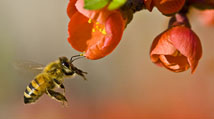 While the word "innovation" is almost ubiquitous, the ability to come up with new ideas that are truly groundbreaking seems to be anything but. Enter honeybees and jackalopes—and how they can lend a hand. (Photo by Louise Docker.)
While the word "innovation" is almost ubiquitous, the ability to come up with new ideas that are truly groundbreaking seems to be anything but. Enter honeybees and jackalopes—and how they can lend a hand. (Photo by Louise Docker.)
ACCIDENTAL CROSS POLLINATION
Bees typically gather nectar and pick up pollen all from the same apple tree. But apple trees need cross-pollination: pollen from one tree must fertilize a different tree. We can't wait around and hope for a bee to accidentally end up on a different tree. What we can count on is that bees will later mix with each other and inadvertently transfer the pollen they've picked up to other bees. Those bees are the important link in growing new apples.
Lesson for hopeful innovators: cross pollinate! Don't hang out with the same people all the time. Get outside your office. Invite people from different departments and different companies to help. Be sure to include front-line employees who probably have excellent perspective on needs that aren't being met.
If you make new friends and create new alliances, you'll get the chance to brush up against some other ideas that would work really well when they transfer to what you're working on.
INTENTIONAL CROSS POLLINATION
A jackalope isn't a real creature, but some will swear it exists. It's said to be a hybrid of the pygmy-deer and a species of killer rabbit. Wall Drug jackalope helps us innovate. Photo by Mbailey.
Wall Drug jackalope helps us innovate. Photo by Mbailey.
The New York Times attributes the mythical creature's origin to a 1932 hunting outing involving taxidermist Douglas Herrick. When he and his brother returned from a hunting trip for jackrabbits, Herrick tossed a carcass into the taxidermy store where it came to rest beside a pair of deer antlers. The accidental combination of animal forms sparked the idea for a jackalope. The rest, as they say, is history.
Lesson for hopeful innovators: mix it up! The Herricks' idea was sparked from an accidental pile of objects. You can purposely mix up some unlikely objects as an idea-starter and see where it leads.
Expose yourself to different magazines, books, TV shows and movie genres than the ones you usually pick. If you normally participate in sports, try learning to draw or dance. Pretty soon, your brain will be connecting dots you haven't seen before.
Some cross pollination "WHAT IFs?"
- Product displays in a law office (bring to life the work done there)
- Cheerleaders in a retirement home (create a festive, team-like atmosphere for residents, their families and employees)
- Hostesses in a tech store (make stressed, bewildered customers relaxed and welcome)
- A "cap and trade" program in a club with attendance requirements (increase membership engagement and reduce turnover)
- Entertainment at a food manufacturing facility (training in disguise)
Two rules of thumb
1) Don't kill ideas before they get a chance to fly. Doug Hall of Eureka! Ranch says the "virtual no" kills more ideas than anything else. Instead of no, say "what if?"
2) Keep an idea file. Get a sketchbook (either old school or virtual) and save clippings, ideas and photos that catch your attention. Scribble and make notes. Don't worry about categorizing or organizing. Just getting these interesting tidbits together in one place creates a deep well of inspiration when you need to work on something new.
Start now.
Do you need some help cross pollinating? Call Martha at 785.969.6203 to talk about growing new ideas, new markets and new profits.
Tags: innovation, creativity, employees, profit



